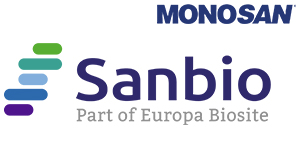Mouse anti-Varicella Zoster Virus, 7 clone cocktail
Mouse anti-Varicella Zoster Virus, 7 clone cocktail
SKU
SANMON-RTU1236
Packaging Unit
7 ml
Manufacturer
Sanbio / Monosan
Availability:
loading...
Price is loading...
Clone Number: SG1-1, SG1-SG4, NCP-1 & IE-62 (7 clone cocktail)
Immunogen: Unknown or proprietery to MONOSAN and/or its suppliers
Concentration: n/a
Storage buffer: Tris Buffer, pH 7.3-7.7, containing 1% BSA and <0.1% Sodium Azide
Additional info: Varicella Zoster Virus (VZV), a member of the human herpes virus family, causes two distinct clinical manifestations: chickenpox and shingles. Primary VZV infection results in chickenpox (varicella), which may rarely result in complications including encephalitis or pneumonia. Even when clinical symptoms of chickenpox have resolved, VZV remains dormant in the nervous system of the infected person (virus latency), in the trigeminal and dorsal root ganglia. In about 10-20% of cases, VZV reactivates later in life producing a disease known as herpes zoster or shingles. Serious complications of shingles include postherpetic neuralgia, zoster multiplex, myelitis, herpes ophthalmicus, or zoster sine herpete. VZV is closely related to the herpes simplex virus (HSV). Affected skin shares so many histological similarities that distinguishing between them may be difficult. Immunohistochemistry with anti-VZV appears quite sensitive and specific on formalin-fixed paraffin-embedded tissues in the distinction between HSV and VZV.
References: Kleinschmidt D, et al. J Neurol Sci. 1998 Aug 14; 159(2):213-8/Kaye SB, et al. Br J Ophthalmol. 2000 Jun;84(6):563-71/A.F. Nikkels, et al. Virchows Archiv A pathol Anat. 1993; 422:121-126
Immunogen: Unknown or proprietery to MONOSAN and/or its suppliers
Concentration: n/a
Storage buffer: Tris Buffer, pH 7.3-7.7, containing 1% BSA and <0.1% Sodium Azide
Additional info: Varicella Zoster Virus (VZV), a member of the human herpes virus family, causes two distinct clinical manifestations: chickenpox and shingles. Primary VZV infection results in chickenpox (varicella), which may rarely result in complications including encephalitis or pneumonia. Even when clinical symptoms of chickenpox have resolved, VZV remains dormant in the nervous system of the infected person (virus latency), in the trigeminal and dorsal root ganglia. In about 10-20% of cases, VZV reactivates later in life producing a disease known as herpes zoster or shingles. Serious complications of shingles include postherpetic neuralgia, zoster multiplex, myelitis, herpes ophthalmicus, or zoster sine herpete. VZV is closely related to the herpes simplex virus (HSV). Affected skin shares so many histological similarities that distinguishing between them may be difficult. Immunohistochemistry with anti-VZV appears quite sensitive and specific on formalin-fixed paraffin-embedded tissues in the distinction between HSV and VZV.
References: Kleinschmidt D, et al. J Neurol Sci. 1998 Aug 14; 159(2):213-8/Kaye SB, et al. Br J Ophthalmol. 2000 Jun;84(6):563-71/A.F. Nikkels, et al. Virchows Archiv A pathol Anat. 1993; 422:121-126
| SKU | SANMON-RTU1236 |
|---|---|
| Manufacturer | Sanbio / Monosan |
| Manufacturer SKU | MON-RTU1236 |
| Package Unit | 7 ml |
| Quantity Unit | STK |
| Reactivity | Human |
| Clonality | Monoclonal |
| Application | Immunohistochemistry (paraffin) |
| Isotype | Mixed |
| Host | Mouse |
| Conjugate | Unconjugated |
| Product information (PDF) | Download |
| MSDS (PDF) |
|

 Deutsch
Deutsch







